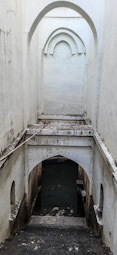Adam Yamey's Blog: YAMEY, page 66
December 26, 2023
Where a famous botanist from Germany used to lecture in Bangalore
DURING AN EXCELLENTLY guided walk through Bangalore’s Lalbagh botanical garden, I saw many parts of the place I had never seen before on several previous visits. One of these new ‘discoveries’ was a small neoclassical building with a triangular pediment on which the ganderberunda (double-headed eagle) of Mysore can be seen in bas-relief.
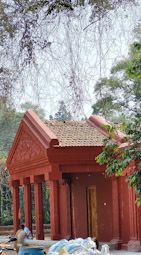
Painted with deep red paint, this small edifice is a recent reconstruction of Krumbiegel Hall, which was first built over 100 years ago (some say in 1860). For many years the original building was neglected, and it fell to pieces. In about 2020, it was rebuilt according to the original plans. So, today it looks brand new.
Gustav Hermann Krumbiegel (1865-1956) was born in Germany near Dresden. He was a botanist and garden designer who came to India in 1893, after having worked in London’s Kew Gardens. He helped to develop the Lalbagh Garden into the wonderful place it has become. Apart from designing the gardens, he introduced many interesting and exotic plants into Lalbagh. His importance in the development of the botanical garden cannot be overestimated.
The original building was used to hold lectures. Krumbiegel was one of those who spoke there. He used to enjoy practicing his speeches and talks in the hall. The construction of the replica of the original hall was stimulated in no little way by the campaigning of Krumbiegel’s great granddaughter, Alyia, who resides in south London.
When I saw the hall yesterday (22nd of December 2023), it was locked up and in front of it were a couple of lamps stands awaiting election. One day, I hope that I will be able to attend a lecture in this hall that has been replicated on the footprint of that which Krumbiegel would have used.
December 25, 2023
The loss of an earring made by a jeweller in Bosnia
ONE MORNING IN Kutch (part of Gujarat), we set off to see a historical monument not far from the town of Mandvi. On the way, we stopped at a cash machine (ATM) to withdraw some cash.
We inserted the debit card and the appropriate PIN code. After keying in the amount we wanted, the machine made the normal noises, and then asked us to remove the cash and our card. To our great dismay it delivered no cash. Yet, we received an SMS stating we had just withdrawn the amount of cash we had keyed in. This worried us greatly.
Fortunately, there was a branch of our bank near the ATM. We spoke with the manager, and explained what had happened. After taking a few details, he resolved the situation and instructed the cashier to give us the cash we had wanted. From his desk, he also managed to ascertain that the ATM had suffered a technical problem.
We drove on towards our intended destination. Despite information on the Internet and on noticeboards, all of which suggested that the place would be open, it was closed. The watchman at the gate explained that the attraction was closed for repair. However, he let us go in for a couple of minutes, after telling us that if anyone saw us enter, he would be in big trouble.
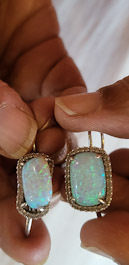
After this second mishap of the day, our driver took us to see a lovely Hindu temple a few miles away. As we began walking around the place, my wife noticed that one of her earrings had become detached. It was one of a pair that a jeweller in Sarajevo (Bosnia) had made. The pair had been made by the uncle of one my Bosnian dental patients, who, having been pleased with my dentistry, had given them to me to present to my wife. These earrings were of great sentimental value, and Lopa was most unhappy to have lost one.
After retracing our steps in the temple compound and failing to find the piece of jewellery, we decided to return to the bank and the ATM, where during the panic of the debit card problem, it might have fallen. On the way, we returned to the closed visitor attraction. We asked the watchman of he had spotted the earring. He had not.
So, we decided to search the part of the driveway, where we had stopped earlier. Lopa and I looked around in vain. Then, our driver joined the search. Within a couple of minutes, he found the earring in the gravel of the roadway. Sadly, either something had driven over it or stepped on it. The earring was intact but the silver stone setting had been distorted. We will have it repaired by Kalim, our skilful jewellery repairer in Bangalore.
They say things happen in threes. That was the case that morning in Kutch. Fortunately, two of the three problems were resolved in a good way.
December 24, 2023
Towers of light at a water tank in Mumbai
HAPPY CHRISTMAS
A DEEPSTHAMBH IS a Hindu architectural feature found near temples or temple compounds. It is a tower with many small niches into which small oil lamps (diyas) are placed and lit to celebrate special Hindu occasions. A good place to see a number of these is at Bombay’s Banganga Tank in the Walkeshwar area.
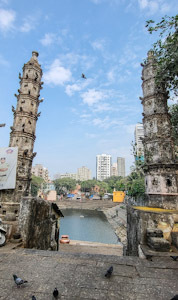 Two deepsthambhs next to Banganga Tank
Two deepsthambhs next to Banganga TankThe tank is a rectangular pool surrounded by steps that lead into the water contained within it. At one corner of the tank water flows from a spring vigorously into the pool. The tank is full of large fish, which the locals feed. Being in a strictly vegetarian neighbourhood, these fish are safe from being caught and eaten. The tank is surrounded by houses and many smallish temples. The Tank is a few yards from the rock strewn seashore.
The tank was first built in 1127 AD by Lakshman Prabhu, a minister in the Sihara Court of Thane. This makes the Tank one of the oldest surviving features of what is now Mumbai. It was rebuilt in 1715. According to legend, the spring that now feeds the Tank appeared suddenly when Rama stopped at this spot during his search for Sita.
Banganga Tank is a pleasant spot at which to linger. So near to the hustle and bustle of Mumbai, here is a place that us both beautiful and relatively peaceful. It gives me a good feeling.
December 23, 2023
The title greatly enhances the photograph.
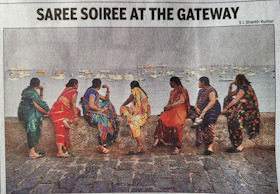
THERE IS A PHOTOGRAPH in the “Times of India” (Mumbai edition: 19th of December 2023). It is a good image showing a group of women wearing saris, and seated on a wall next to the sea close to the Gateway of India. The picture on its own is a pleasure to see, but what enhanced my enjoyment of it was its wonderfully witty title:
“SAREE SOIREE AT THE GATEWAY”
December 22, 2023
A cat at Crawford Market
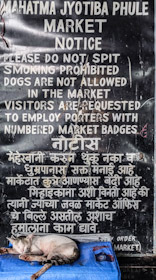
No dogs are allowed
In the busy food market hall
But cats – welcome
December 21, 2023
Pop Art on show in a gallery in Bombay
DURING THE FEW DAYS we have been in Bombay, we have visited 10 art galleries. With one exception, the exhibitions have been both beautifully displayed and contained exciting works of art. The exception is an exhibition of Pop Art being held at the recently constructed Nita Mukesh Ambani Cultural Centre in the Bandra Kurla district of Bombay.
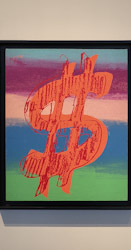
The spacious gallery occupies parts of four floors of a glitzy cultural centre-cum-shopping mall. To view the exhibition, one needs to book a time-slot, and part with 800 Rupees (about £8) per person. When we visited on a Sunday afternoon, the few visitors to the gallery were vastly outnumbered by security personnel and charming, but seemingly poorly informed, young ladies who are employed to provide information about the exhibits.
The flyer for the exhibition promises the visitor the opportunity to see works by 12 exponents of Pop Art. However, the majority of the items were creations of Andy Warhol. Almost my favourite piece was a large creation by Robert Rauschenberg.
Each of the very spacious, well-lit galleries had surprisingly few artworks. Of the four galleries, I thought that the one on the third floor was best. It contained, amongst a few other things, the Rauschenberg, and a work by Claes Oldenburg, and yet more Warhol images.
Would I recommend making a visit to this exhibition? Probably, I would not. If you are familiar with Pop Art it offers little to add to what you already know and/or like. If you are not familiar with this kind of art, I am not sure that the exhibition would provide you with much if any insight. And at 800 Rupees per person, you might be better off buying a decent book about this exciting era of art.
December 20, 2023
Bargaining for a book in Bombay
NEAR BOMBAY’S FLORA Fountain there are several booksellers on the pavement. They stock both new (original and pirated copies) and old books. In general, the vendors are amenable to bargaining with their customers.
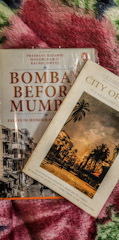
Today (in December 2023), I found a second-hand, oldish book about the history of Bombay. It looked as if it would satisfy my requirements. I asked the price. It was 800 Rupees. Because I have become accustomed to hagling over the price I offered 600. I was hoping that we would eventually agree on a price of about 700. The bookseller was adamant. He would sell it for 800 and no less. He kept saying it had been 1000 when it was new … long ago. I walked away, and viewed other bookstalls nearby.
Keen to have the book, I returned and offered 750. The stubborn vendor said to me:
“What is 50 Rupees to you? You are rich man.”
I walked away, and joined my wife who had just engaged a taxi to take us elsewhere. Seeing me board the taxi, the bookseller ran up to our vehicle, and proposed that we pay 780. My wife, who was not yet in the vehicle, offered him 750, which he accepted.
The man was right. What was 50 Rupees to me? Only about 50 pence. However, that was not the point. Getting the book was one thing but the pleasure of fighting to reduce the price, and succeeding, is another. And the sense of achievement after serious bargaining leaves me with a curiously fine sense of contentment.
December 19, 2023
Bats in a baobab tree in Bombay
I HAVE SEEN PHOTOGRAPHS of baobab trees, but until we visited the café of the formerly named Prince of Wales Museum in Bombay, I had never seen one ‘in the flesh’. A member of the mallow family of plants, baobabs are native to Madagascar.
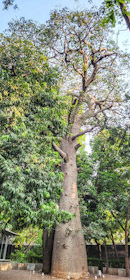 Baobab tree in Bombay
Baobab tree in Bombay These trees with curious looking conical trunks were imported to India by Arab traders. Although this is the case, this baobab in Bombay is the first such tree I have seen during my 30 years of frequent visits to India.
As we sat with our cold drinks, I looked up at the high branches of the baobab, and saw something flapping about. At first, I thought it was a black plastic bag caught in the branches. Then I noticed that it was a large bat stretching its wings. I saw it was not alone, but one of a large number of bats hanging on the high branches. These large creatures had black wings and dark brown bodies.
Despite the fact we had just seen a wonderful exhibition of ancient sculptures (from India, Ancient Rome and Greece, and Assyria), finding the baobab and seeing the bats in it, made my day.
December 18, 2023
An iconic but ironic famous landmark in Mumbai
WE HAVE BEEN VERY fortunate to get a booking at the Royal Bombay Yacht Club, located next door to the world famous luxurious Taj Mahal Hotel. Our bedroom is directly opposite the front of the Gateway of India – Bombay’s best known landmark.
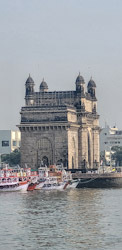
The Gateway was built to celebrate the arrival in India of the British King George V – Emperor of India. However, as it was only completed in 1924, the king only got to see a cardboard model of the archway. Construction of this edifice only began in 1915, when the land on which it now stands was first prepared. The Gateway’s foundations only began to be built in 1920.
The magnificent archway was designed by George Wittet (1878-1926), an architect who worked mainly in Bombay. The Gateway was designed in an Indo-Saracenic style with many features borrowed from 16TH mosques found in Gujarat.
The Gateway is a brilliant piece of architecture. In its position next to the sea, it ‘works’ successfully. It has become not only an icon of Bombay but also, I believe, of India. I find it ironic that like that other icon of India, the Taj Mahal in Agra, its construction was inspired not by Indians but by invaders of the Indian Subcontinent. Despite that, Indians love it and flock to see it.
December 17, 2023
Temple bells and a stepwell in Surat (Gujarat)
NOBODY KNOWS WHEN the Bahucharaji stepwell was constructed. Legend has it that this well, located in Surat’s Vishal Nagar area, was built by Vanjara people, who came from outside Surat. These people used to visit the city, and set up camp there. This stepwell is said to have been dug by them to provide a supply of water.
The Vanjaras (Banjaras) are descendants of nomadic traders. Found in many parts of India, they used to have an important role in the economy of the Subcontinent. Wikipedia related that:
“… the Banjaras had a monopoly on the movement of salt prior to the arrival of the East India Company. More generally, they also traded in cattle, moving the beasts around the country’s bazaars, and they rented out their carts. Although some older sources have suggested that they did not use credit, Habib’s analysis of historic sources suggests that they did and that some were reliant on it.”
A Hindu goddess called Mataji appeared in the dream of a Vanjara and inspired the construction of the stepwell. After the vav (stepwell) was constructed, a temple was built within it. This is dedicated to Mataji.
The entrance to the stepwell is within a temple compound, in which footwear must be removed. We visited the place on a Sunday morning in December 2023. A steady stream of worshippers of all ages entered the stepwell’s ground level entrance. As they descended the steps towards the water in the bottom of the vav, they sounded the temple bells suspended above the staircase. Before reaching the water, the steps pass two shrines each containing effigies of Hindu deities. At one of them, a lady in a beautiful sari was involved in a lengthy puja conducted by a priest. She was accompanied by a large-ish group of people. I noticed that some of them were holding on to her sari.
We squeezed past the group and descended further into the vav until we reached a railing from which we had a clear view of the water far below us. Several tortoises were resting on the step closest to the water in the well.
After admiring the beautifully maintained vav, we left the temple compound. Outside it, we spotted some beautiful cockerels wandering around. A few days earlier in Surat when we were visiting another temple dedicated to Mataji, we saw cockerels and were told that the goddess favoured these creatures. Above the entrance to the Bahucharaji Stepwell compound, there is a bas-relief depicting Mataji astride a cockerel.
As for Mataji, I will not try to explain her because, for me trying to explain anything about Hinduism is nearly impossible. All I can say is that for Hindus, it seems that their beliefs and rituals are simply a part of the rhythm of daily life, rather than something compartmentalised as is often the case for Europeans.
